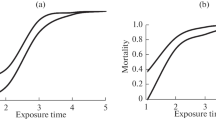Abstract
System level effects exhibited by a population subjected to a chronic or an acute dose of toxicant are the emphasis of this study. A three dimensional model of a toxicant and a population, with state variables (the population biomass, the concentration of toxicant in an organism, and the concentration of toxicant in the environment) coupled by a linear dose-response function, is analyzed analytically. One of the main results presents sufficient conditions, in terms of a system level parameter, for the persistence, and for the extinction, of a population exposed to a chronic dose of toxicant. When depuration and degradation are negligible processes, the effects of toxicant accumulation associated with an acute exposure of a population are analyzed in some detail. Both persistence and extinction are shown to be viable behavior modes of a population in this biochemical setting.
Similar content being viewed by others
References
Branson, D. R., Blau, G. E., Alexander, H. C., Neely, W. B.: Bioconcentration of 2, 2′, 4, 4′, tetrachlorobiphenyl in rainbow trout as measured by an accelerated test. Trans. Amer. Fish Soc. 104, 785–792 (1975)
Butler, G. C.: Principles of ecotoxicology, Scope 12, 350 pp. New York: Wiley 1978
Coppel, W. A.: Stability and asymptotic behavior of differential equations, 166 pp, Boston: Heath 1965
Curtis, E. H., Beauchamp, J. J., Blaylock, B. G.: Applications of various mathematical models to data from the uptake of methylmercury in bluegill sunfish (Lepomis Macrochirus). Ecol. Modelling 3, 273–284 (1977)
Filov, V. A., Golubev, A. A., Liublina, E. I., Tolokonstev, N. A.: Quantitative toxicology, 462 pp. New York: Wiley 1979
Hallam, T. G., Clark, C. E., Lassiter, R. R.: Effects of toxicants on populations: A qualitative approach I. Equilibrium environmental exposure. Ecol. Modelling 18, 291–304 (1983)
Lakshmikantham, V., Leela, S.: Differential and integral inequalities, Vol. I. New York: Academic Press 1969
Lassiter, R. R., Baughman, G. L., Burns, L. A.: Fate of toxic organic substances in the aquatic environment. In: State-of-the-Art in Ecological Modelling (S. E. Jorgensen, ed.) Int. Soc. Ecol. Mod. Copenhagen, pp. 219–245 (1978)
Norstrom, R. J., McKinnon, A. E., deFreitas, A. S. W.: A bioenergetics-based model for pollutant accumulation by fish.. Simulation of PCB and methylmercury residue levels in Ottawa River yellow perch (Perca flauecens). J. Fish. Res. Board Can. 33, 248–267 (1976)
Thomann, R. V.: Equilibrium model of fate of microcontaminants in diverse aquatic food chains. Can. J. Fish. Aquat. Sci. 38, 280–296 (1981)
Veith, G. D., DeFoe, D. L., Bergstedt, B. V.: Measuring and estimating the bioconcentration factor of chemicals in fish. J. Fish. Res. Board. Can. 36, 1040–1048 (1979)
Webster, J. R., Crossley, D. A., Jr.: Evaluation of two models for predicting elemental accumulation by arthropods. Environ. Entomol. 7, 411–417 (1978)
Author information
Authors and Affiliations
Rights and permissions
About this article
Cite this article
Hallam, T.G., Clark, C.E. & Jordan, G.S. Effects of toxicants on populations: A qualitative approach II. first order kinetics. J. Math. Biology 18, 25–37 (1983). https://doi.org/10.1007/BF00275908
Received:
Issue Date:
DOI: https://doi.org/10.1007/BF00275908




